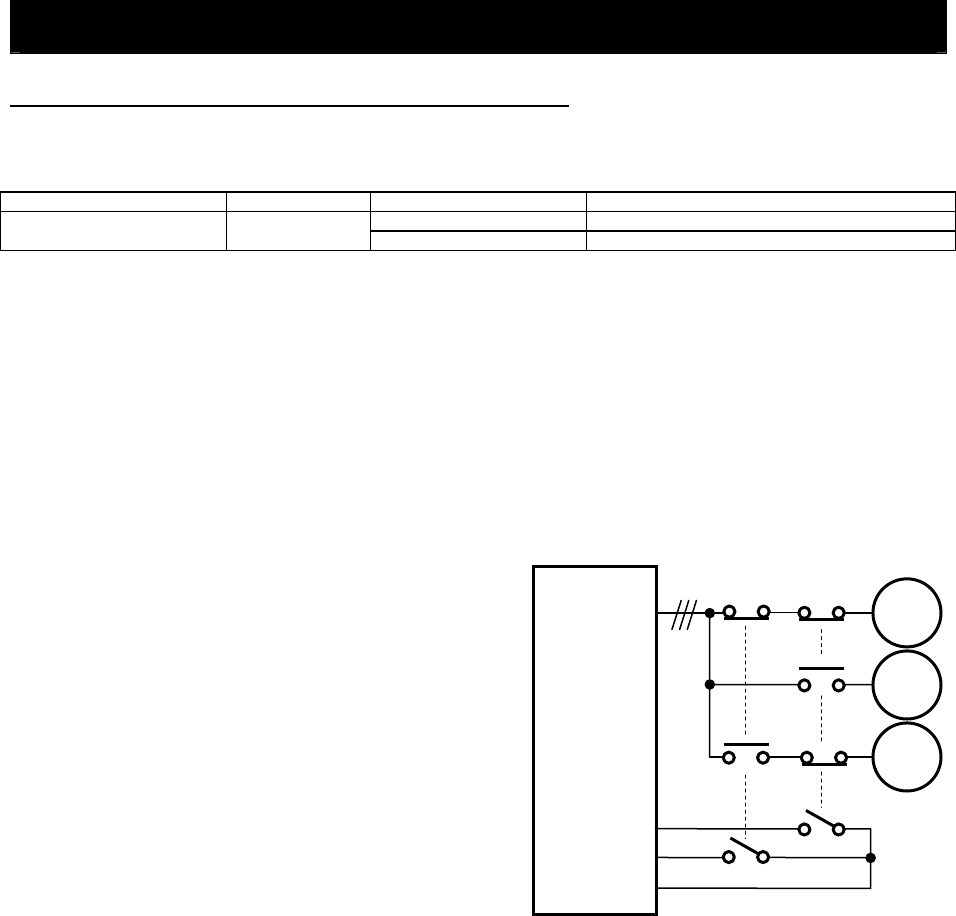
Chapter 4 Explanation of Functions
4.2.43 2nd/3rd motor control function (SET and SET3)
This motor control function allows you to switch the inverter settings to control three different types of
motors. To use this function, assign function "08" (SET) and "17" (SET3) to two of the terminal [1] to [8]
functions (C001 to C008). Turn the SET and SET3 terminals on and off for switching.
Item Function code Data Description
08 SET: Set 2nd motor data
Terminal function C001 to C008
17 SET3: 3rd motor control
You can switch the following functional settings with the SET or SET3 terminal:
F002/F202/F302: Acceleration (1) time setting, 1st/2nd/3rd motors
F003/F203/F303: Deceleration (1) time setting, 1st/2nd/3rd motors
A003/A203/A303: Base frequency setting, 1st/2nd/3rd motors
A004/A204/A304: Maximum frequency setting, 1st/2nd/3rd motors
A020/A220/A320: Multispeed frequency setting, 1st/2nd/3rd motors
A041/A241: Torque boost method selection, 1st/2nd motors
A042/A242/A342: Manual torque boost value, 1st/2nd/3rd motors
A043/A243/A343: Manual torque boost frequency adjustment, 1st/2nd/3rd motors
A044/A244/A344: V/F characteristic curve selection, 1st/2nd/3rd motors
A046/A246: Voltage compensation gain setting for automatic torque boost, 1st/2nd motors
A047/A247: Slippage compensation gain setting for automatic torque boost, 1st/2nd motors
A061/A261: Frequency upper limit setting, 1st/2nd motors
A062/A262: Frequency lower limit setting, 1st/2nd motors
A092/A292/A392: Acceleration (2) time setting,
1st/2nd/3rd motors
4 - 50
A093/A293/A393: Deceleration (2) time setting,
1st/2nd/3rd motors
A094/A294: Select method to switch to Acc2/Dec2
profile, 1st/2nd motors
A095/A295: Acc1 to Acc2 frequency transition point,
1st/2nd motors
Motor
1
Motor
2
Inverter
U
V
W
SET
CM1
Motor
3
SET3
A096/A296: Dec1 to Dec2 frequency transition
point, 1st/2nd motors
b012/b212/b312: Electronic thermal setting
(calculated within the inverter from
current output), 1st/2nd/3rd motors
b013/b213/b313: Electronic thermal characteristic,
1st/2nd/3rd motors
H002/H202: Motor data selection, 1st/2nd motors
H003/H203: Motor capacity, 1st/2nd motors
H004/H204: Motor poles setting, 1st/2nd motors
H005/H205: Motor speed constant, 1st/2nd
motors
H006/H206/H306: Motor stabilization constant,
1st/2nd/3rd motors
H020/H220: Motor constant R1, 1st/2nd motors
H021/H221: Motor constant R2, 1st/2nd motors
H022/H222: Motor constant L, 1st/2nd motors
H023/H223: Motor constant Io, 1st/2nd motors
H024/H224: Motor constant J, 1st/2nd motors
H030/H230: Auto constant R1, 1st/2nd motors
H031/H231: Auto constant R2, 1st/2nd motors
H032/H232: Auto constant L, 1st/2nd motors
H033/H233: Auto constant Io, 1st/2nd motors
H034/H234: Auto constant J, 1st/2nd motors
H050/H250: PI proportional gain, 1st/2nd motors
H051/H251: PI integral gain, 1st/2nd motors
H052/H252: P proportional gain setting, 1st/2nd motors
H060/H260: Zero LV lmit, 1st/2nd motors
Since the inverter indicates no distinction among the 1st, 2nd, and 3rd controls, confirm the kind of control
settings with the on/off states of the SET and SET3 terminals.
If both the SET and SET3 terminals are turned on, the SET terminal has priority, and the 2nd control is
selected.
While the inverter is operating the motor, switching between the 1st, 2nd, and 3rd when motor stops
controls is disabled. Switching the motor control is valid onlywhen the motor is stopped,so change is
reflected after the operation .
The above setting items printed in italic, bold type can be adjusted even while the inverter is operating the
motor. (Whether each item can be set during operation and whether it can be changed during operation
are indicated in the list of data settings in Chapter 8.)


















